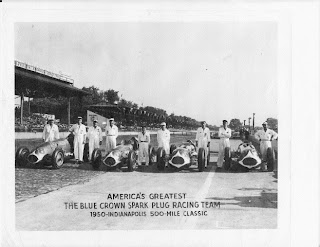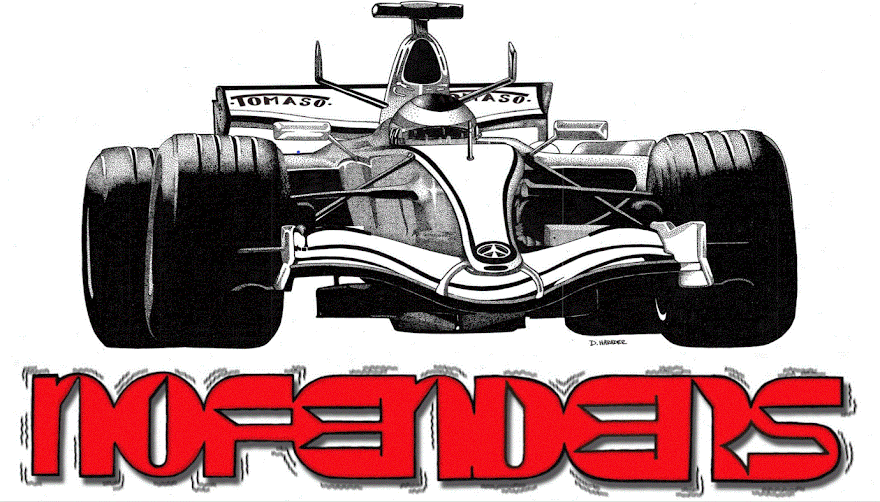Having won three consecutive Indianapolis
Dean Jackson:
Along with the two Indy cars, there were also two Dirt Track racers built, with Driver’s including: Lee Wallard, Henry Banks and Tony Bettenhausen Sr., whom my Dad gave him his first ride in a “Big” car in 1939.
Bill Holland was an excellent driver while Mauri Rose and Tony Bettenhausen were also very good hard charging racers; but the latter were harder upon their equipment...
1950: Moore
Having become the first winner of three consecutive Indy 500’s, Lou Moore added a fourth car to his stable in his efforts to garner an unprecedented fourth consecutive victory. Bill Holland and George Connor returned in their previous year’s chassis, while new recruits Lee Wallard was entrusted with the brand new rear drive Dirt Car and Tony Bettenhausen (Senior) was given the ex-Rose front drive Offenhauser Champion Car.
 |
| 1950 Blue Crown Spark Plug Team Photo (DJP) |
Meanwhile, Mauri Rose had found a new steed to pilot, taking the wheel of another chassis Emil Deidt had built in 1948 for Superior Oil tycoon Howard Keck, who would campaign several drivers over the years.
Rose replaced Keck’s original driver Jimmy Jackson, as the unsung Jackson who’d piloted the Deidt/Offy entry to a pair of 10th place finishes the prior two years, moved onto drive the Cummins Diesel entry.
NOTE
The Indy 500 became part of the Formula 1 Driver’s World Championship between the years of 1950-60 and hence, all participants taking part in the Indianapolis 500 during these years were awarded Grand Prix Championship points for finishing positions 1-5 between 1950-59; and 1-6 in 1960.
Thus, while Moore’s four car armada of Connor, Bettenhausen, Holland and Wallard started fourth, eighth, tenth and twenty-third respectively, It was Rookie Walt Faulkner winning the pole position, which came as a total surprise, as Faulkner who’d seemingly come out of nowhere knocked off another surprise pole sitter named Fred Agabashian at the last moment.
And in what has become increasingly common in past years, at the time of the 34th running of that year’s Indy 500; for only the second time ever, with 1925 being the first, the race was halted early due to rain.
Yet the eventual first two finishers of that year’s shortened race were simply inverted from the previous year’s event, with Johnny Parsons winning and bill Holland
1951
Interestingly, the winning car had originally been built for Meyer & Drake by Frank Kurtis in 1949, before their customers complained about competing against the factory and the car was sold to Murrell Belanger with Tony Bettenhausen as part of the deal. Since he’d been Meyer & Drake’s hired gun, although Tony was still willing to drive the “experimental” race car on the Dirt Tracks, he told Belanger that he wished to drive for Lou Moore instead at Indy as he still believed that the front wheel drive racecar’s held an advantage over the rear drive chassis. Hence Tony recommended Lee Wallard as his substitute... With Wallard going on to victory, while Bettenhausen spun out of the race from fifth place in the closing stages... And thus, once again ‘Tony had given up a winning ride! Having been unwilling to break ranks and accept Lou Moore’s ride in 1947.
 |
| George Connor; 1950 (DJP) |
Noting Bettenhausen’s decision to drive once again for Moore, I came to surmise that Lou Moore must have entered four race cars for the Indy 500, albeit this time only two were Blue Crown Spark Plug Specials; one being driven by reigning AAA National Champion Henry Banks, in the No. 1 Moore/Offy, driven the previous year by Lee Wallard. While Bank’s sister No. 22 Blue Crown entry, was the Lesovsky/Offy chassis, piloted by George Connor for a third successive year, these being the two rear drive chassis Moore had previously commissioned.
Meanwhile Bettenhausen was aboard the No. 5 Mobil Oil Special and Duane Carter was driving the No. 27 Mobilgas Special, both of these entries being the earlier built front drive Deidt chassis.
Thus, with a total of four Deidt/Offenhauser racecars, plus the two aforementioned Blue Crown entries contesting that year’s event, the No. 19 Tuffanelli-Derrico entry driven by Mack Hellings was possibly entered by somewhat obscure Car Owner Gordon Schroeder? While once again Mauri Rose was behind the wheel of Howard Keck’s No. 16 entry, although the front (wheel) “drivers” were now seeming to lose some of their advantage at the Speedway, as this year’s front row was locked out by Frank Kurtis chassis, with Duke Nalon on pole in the revered Novi.
Meanwhile, in what seems a strange incident, Bill Holland, having moved to Miami Holland
Holland then crucified the AAA in his local media to no avail, being forced to sit out that year’s Indy 500 after having finished second three times and winning once the previous four years...
Holland, still not having gotten the memo and continuing to trash the AAA, was further demoralized when his application for reinstatement was denied a second time, being forced to miss the 1952 season as well, before finally being cleared to return to competition at the Speedway in 1953! As apparently Holland Moore
Yet the race was fraught with attrition, with only six cars finishing on the lead lap, as Banks was the highest Moore team finisher in sixth place, while Carter wound-up eighth, Bettenhausen ninth and Connor 21st, having retired with a Driveshaft failure, while Mack Hellings retired on lap 18 with a piston failure
And after having fallen out of the race from a broken wire wheel suffered with just under 75 laps remaining, triple Indy 500 winner Mauri Rose would retire from competition the following January...
1952
From what I can tell, this was Lou Moore’s final season as an Indy Car team owner, as Moore had already won the event a record five times and was preparing to switch his attention full time to NASCAR...
Dean Jackson:
Blue Crown also sponsored Hudson
 |
| Frank “Rebel” Mundy; “To P.D. a real racing friend + sport... Best wishes” Frank “Rebel” Mundy” (DJP) |
Yet, Moore’s team did contest the Indy 500 that year, albeit apparently having reduced his effort from four cars to two, with entries for Henry Banks and Tony Bettenhausen (Sr.) as Bill Holland was still sitting on the sidelines, with the AAA intent to show the racing drivers just exactly who was boss!
With Rose’s retirement, Howard Keck had hired west Coast hot-shoe Bill Vukovich to take over and would ultimately bring Keck his long sought Indy triumphs in 1953-54.
Meanwhile, Banks rolled off 12th and finished 19th, while Bettenhausen started from the final row in 30th and finished 24th after stalling and retiring on lap 93. As the face of the Speedway
1953-56: The Stock Car years
For the years 1953-56, I have been unable to gather any substantial information about Moore
Dean Jackson:
“Oh, you’d better write down Frank “Rebel” Mundy.”
(NASCAR Hudson
Also according to Donald Davidson; Frank “Rebel” Mundy carried Blue Crown Spark Plug sponsorship on his Hudson Hornet in 1953; so, I’m guessing that Mundy drove with Blue Crown backing between 1953-54 for Lou Moore? And that perhaps either after the 1953 or ’54 seasons, Blue Crown finally got out of the race car sponsorship business altogether...
Although I’d never heard of Frank “Rebel” Mundy before, he seems to be quite the character, having driven in NASCAR between 1949-56, although I don’t know if all of the latter year’s were with Lou Moore? As I’ve had a tough time finding anything substantial on this stock car driver, other then he won three races in the No. 23 along with four poles, the majority of these coming behind the wheel of a Studebaker... Having even once won in a rental car that had cost him $25.00 for the day. Mundy’s real name was Francisco Eduardo Menendez and he had once been a chauffer for General Patton during World War II.
 |
| Hudson Hornet/Frank Mundy (DJP) |
Furthermore, I’m assuming Moore Moore
Trivia
Was Lou Moore’s entry of four Blue Crown Spark Plug Specials entered at Indianapolis
If you said no, its Andretti Green racing’s tally of five entries in 2006-07, you’re wrong! (As this was prior to the 2009-12 seasons or Andretti Autosport...) As the correct answer is Cliff Durant in 1923 with seven entries. (Since the 10-Fords in 1935 were allotted to different teams...)
For the conclusion of this story, see; Blue Crown Spark Plug Specials-Statistics
Special Thanks to:
Joy for introducing me to Dean...
Dean Jackson
Without Dean’s willingness to tell me his story, provide me the details and graciously sending me multiple photographs of the Blue Crown Spark Plug Specials;
THERE WOULD BE NO STORY!
Donald Davidson
For taking time out of his busy schedule to call me twice to answer my arcane questions about the Blue Crown Spark Plug racing cars and the Old Timers era...
Books
Autocourse: The Official History of the Indianapolis
By Donald Davidson and Rick Shaffer.
Offenhauser
The Legendary Racing Engine an the Men who built It
By Gordon Elliot White.
Miller
By Griffith
City of Speed
By Joe Scalzo.
Internetz
Lou Moore; Emil Deidt; Driver Bio’s; IMS Statistics; Lucy O'Reilly Schell/Maserati, etc.
(DJP: Dean Jackson Photographs)
